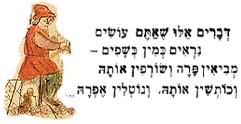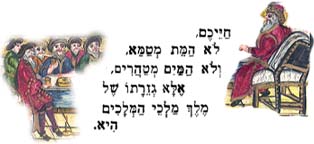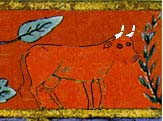|
The passage under consideration has been an embarrassment to some, a puzzlement
to many, and a curiosity to all its readers. It is part of the annual cycle
of synagogue Scripture readings and is read in traditional synagogues three
weeks before the Passover to remind the community of the importance of approaching
that festival in a state of ritual purity.
The text is an isolated one,
having no connection with what appears before it or with what follows it. It
tells of the ingredients and the effects of the purifying water to be used in
the case of the pollution that derives from contact with a dead body. The mode
of purification that is here described makes possible a return to a state of
kedusha, or sanctification. It is needed for both vessels and people.
Most specially to be noted are the words in verse 9, hatat hi, appearing
in our translation as, "it is for cleansing"; in the Revised English
Bible it is "a purification offering." The old Jewish Publication
Society translation of 1917 reads, "it is a purification from sin."
Those words will help us to understand the way in which an ancient folk custom
was introduced into the sacred ritual of the priesthood.
The notion
that a dead body pollutes is both primitive and widespread; evidence of it is
found on the American, African, and Asian continents and appears in the cultures
of ancient Greece and Rome. This popular ancient belief that contact with a
corpse produced the most severe impurity and that the spirit of the dead could
exert control over anyone who had contact with the body, necessitated some sort
of ceremonial process of exorcism. Ashes and the color red (like blood) are
known from folklore to be an effective means of protection from evil spirits.
Among the early
Israelite people, the hold of the ancient ritual of the ashes of the red heifer
was so strong that despite its pagan antecedents, it was not only not discontinued,
but was incorporated into priestly procedures. It was this association with
priestly regulations that kept the custom alive, but also separated it from
its original belief.
According
to Jacob Milgrom,[1]
corpse contamination "evoked an obsessive irrational fear in individuals."
This helps us understand the persistence of a purifying practice through
various stages of religious development. In the biblical tradition, this
purifying practice became the hatat, the "purification offering."
Since it is the blood that causes the contamination in the first place,
the blood of the red cow was poured on the horns of the altar, a homeopathic
process by which the source of the contamination is also the means for
its removal. Here we must note the seeming paradox in which the same substance
that provides purification for the contamination also contaminates those
who are in contact with it. In the purifying process, the ashes of the
red heifer absorb the impurity they are meant to remove and become impure
in the process.
 The
significance of incorporating an ancient and popular ceremony of exorcism into
the sacrificial system must not be overlooked. It represents a transition from
magic to religion. Whatever may have been the original intent in the use of
the ashes of the red heifer for purification purposes, once introduced into
the sacrificial system, the steps taken became part of a larger ceremonial system
in which their efficacy derived from obedience to God's law, and not from the
specific and magical properties of the agents used. This transition from magic
to religion is reflected in a tale told in the Midrash to the book of Numbers,
concerning an exchange between Rabbi Johanan ben Zakkai and his students:[2] The
significance of incorporating an ancient and popular ceremony of exorcism into
the sacrificial system must not be overlooked. It represents a transition from
magic to religion. Whatever may have been the original intent in the use of
the ashes of the red heifer for purification purposes, once introduced into
the sacrificial system, the steps taken became part of a larger ceremonial system
in which their efficacy derived from obedience to God's law, and not from the
specific and magical properties of the agents used. This transition from magic
to religion is reflected in a tale told in the Midrash to the book of Numbers,
concerning an exchange between Rabbi Johanan ben Zakkai and his students:[2]
 An
idolater asked R. Johanan Ben Zakkai: "These rites that you perform look
like a kind of witchcraft. You bring a heifer, burn it, pound it, and takes
its ashes. If one of you is defied by a dead body you sprinkle upon him two
or three drops and say to him: ‘You are clean!' An
idolater asked R. Johanan Ben Zakkai: "These rites that you perform look
like a kind of witchcraft. You bring a heifer, burn it, pound it, and takes
its ashes. If one of you is defied by a dead body you sprinkle upon him two
or three drops and say to him: ‘You are clean!'
R.
Johanan asked him: "Has the demon of madness ever possessed you?"
"No,"
he replied.
"Have you ever seen a man possessed by this demon of madness?"
"Yes,"
said he.
"And what do you do in such a case?"
"We bring roots," he replied, "and make them smoke under
him, then we sprinkle water upon the demon and it flees."
Said R. Johanan to him: "Let your ears hear what you utter with you
mouth! Precisely so is this spirit a spirit of uncleanness. Water of purification
is sprinkled upon the unclean and the spirit flees."
When
the idolater had gone, R. Johanan's disciples said to their master: "Master!
You have thrust off that heathen with a mere reed of an answer, but what
explanation will you give to us?"
Said
he to them: "By your life! It is not the dead that defiles nor
the water that purifies! The Holy One, blessed be He, merely says, ‘I
have laid down a statute, I have issued a decree. You are not allowed
to transgress My decree.' [Numbers 19:2]"
Rabbi Johanan does
not try to give to his students the rationale for the practice, which
apparently was satisfactory for the inquiring pagan; the latter came
from a religious culture in which it was readily comprehensible that
the impurity of contamination from a corpse could be drawn out of a
person through contact with the ashes of the red heifer. For the pagan,
the test lay in the magical efficacy of the cleansing object. For Rabbi
Johanan's Jewish students, however, "efficacy" had no pertinence
whatsoever. The contaminated object was cleansed, he explained, simply
because the divine text said it was, not because of anything that had
happened to it per se.
 Indeed,
according to tradition, the account of the red heifer is one of the four Torah
laws that cannot be explained by human reason but that, nevertheless, demands
obedience.[3]
It is said that even King Solomon, who learned the logic of all God's commandments,
was unable to discern the logic of the red heifer. In the absence of any compelling
logical reasoning, it is not surprising that our passage under discussion
evoked a variety of poetic, metaphoric, and homiletic responses. Indeed,
according to tradition, the account of the red heifer is one of the four Torah
laws that cannot be explained by human reason but that, nevertheless, demands
obedience.[3]
It is said that even King Solomon, who learned the logic of all God's commandments,
was unable to discern the logic of the red heifer. In the absence of any compelling
logical reasoning, it is not surprising that our passage under discussion
evoked a variety of poetic, metaphoric, and homiletic responses.
The medieval Hebrew
commentator, Rashi, in the name of Rabbi Moshe the Preacher, says the
heifer came to atone for the calf. "The sin of the golden calf
was from a lack of faith and, as appropriate penitence, the commandment
of the heifer was given to them. It was a statute, a commandment with
no logic, and its observance could come only from the strength of faith."
Not even the trespass of the golden calf was immune to the benign ministration
of the red heifer's atonement.
Rabbi
Samson Raphael Hirsch, the 19th-century German rabbi and scholar, saw
the ceremony of the red heifer as a reflection of the tension between
body and soul. Every corpse proclaims the mortality of all humanity and
calls attention to the finiteness of human existence and human inability
to effect any change in this regard. By contrast, the expiating hatat
purges the sinner and directs us to a spiritual realm where we can choose
between what is pure and impure. The laws of purity remind us that in
matters of morality, we are in control: "Human beings can be free
of sin, can become so, and remain so."
It is we who sanctify
life. Purity and impurity do not inhere in objects, rites or in ceremonies.
It is we who ascribe sanctity to things, we who can put all things to
noble purpose. It is we, who in our search for the sacred even in the
profane, hold eternity in our hearts.
Afterword:
In
recent years, the controversial archaelogist Vendyl Jones has conducted
an archaelogical dig at the Qumran caves, where he believes the ashes
of the red heifer were hidden in ancient times. [4]
Others, members of religious cults interested in rebuilding the third
Temple and reinstating the Temple cult, have undertaken to breed a red
heifer without a blemish. [5]
|
|
[1]
Numbers, The Torah Commentary (Philadelphia: Jewish Publication Society,
1990): 441 [back]
[2] Tanhuma B, Hakkut 26; PR 14:14; Numbers R. 19:8 [back]
[3] The remaining three laws are: the requirement of a
man to marry the widow of his childless brother (Deut. 25:5-10); the injunction
against wearing garments woven of different threads (Deut. 22:11); and
the sending of the goat into the wilderness to Azazel (Lev. 16). [back]
[4] Biblical Archaelogist 59:2 (1996) [back]
[5] Yulish, Stephen M. Ph.D., "Ashes of the Red Heifer",
March 23, 1997;
Weiss, Rick, "Scientists Achieve Cloning Success" Washington Post, Feb.
24, 1997; The Mid-East Dispatch, 237, March 16, 1997 [back] |
|
Reprinted
by permission of the author from Preaching Biblical Texts: Expositions
by Jewish and Christian Scholars, ed. Frederick C. Holmgren and
Herman E. Schaalman. Published by William B. Eerdmans Publishing Company,
Michigan, 1995.
|
|
Jerome
Malino is a former president of the Central Conference of American Rabbis
and Adjunct Lecturer in Homiletics at the Hebrew Union College-Jewish
Institute of Religion. Dr. Malino has served as President of the Institute
on Religion in the Age of Science, has contributed to professional journals,
and published original and translated poetry. |
COLOR
Table of Contents
|